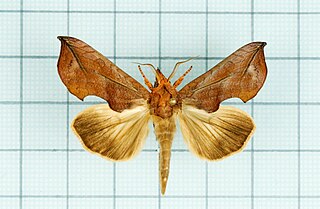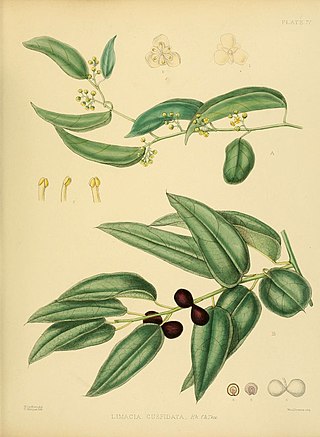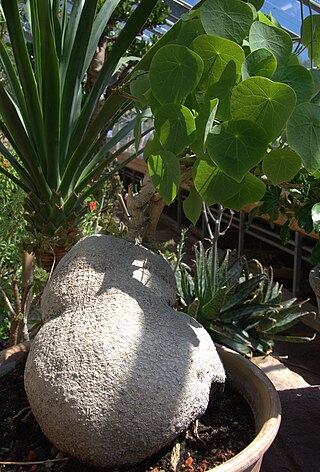
Menispermaceae is a family of flowering plants. The alkaloid tubocurarine, a neuromuscular blocker and the active ingredient in the 'tube curare' form of the dart poison curare, is derived from the South American liana Chondrodendron tomentosum. Several other South American genera belonging to the family have been used to prepare the 'pot' and 'calabash' forms of curare. The family contains 68 genera with some 440 species, which are distributed throughout low-lying tropical areas with some species present in temperate and arid regions.

Stephania is a genus of flowering plants in the family Menispermaceae, native to eastern and southern Asia and Australia. They are herbaceous perennial vines, growing to around four metres tall, with a large tuber. The leaves are arranged spirally on the stem and are peltate, with the leaf petiole attached near the centre of the leaf. The name Stephania comes from the Greek, "a crown". This refers to the anthers being arranged in a crown-like manner.
Stephania reticulata is a shrub native to Thailand, Malaysia and Indonesia described by Lewis Leonard Forman.
Stephania is a genus of flowering plants in the family Menispermaceae.

Oraesia excavata is a species of moth of the family Erebidae first described by Arthur Gardiner Butler in 1878. It is found in Japan, Korea, China, Thailand and Taiwan and has recently been recorded from Hawaii.
Stephania crebra is a herbaceous perennial vine in the genus Stephania of the family Menispermaceae. It is native to Southeast Asia and was first described in Thailand in 1988 by L. L. Forman. It is one of 15 Stephania found only in northern Thailand, specifically in the province of Chiang Mai. It has leaves 12–17 cm (4.7–6.7 in) long and 9–16 cm (3.5–6.3 in) wide. It resembles Stephania reticulata but S. crebra has larger flowers but smaller drupes and endocarps.
Lewis Leonard Forman was a British botanist, born in London. He was an expert on spermatophytes, particularly Menispermaceae, and specialised in the plants of Southeast Asia. He graduated from the University of London in 1950 and was appointed to the staff of the Royal Botanic Gardens, Kew in 1951, serving as a senior official there from 1966 to 1989.
Cyclea elegans is a species of flowering plants in the family Menispermaceae. It is found in Sumatra, Malaya, Borneo. An isotype is kept at Kew Gardens Herbarium. It was collected on Mount Kinabalu Dallas.

Haematocarpus is a plant genus in the family Menispermaceae and found in south-east Asia.
Pericampylus is a genus of flowering plants belonging to the family Menispermaceae.
Albertisia is a genus of flowering plants belonging to the family Menispermaceae.

Carronia is a genus of flowering plants belonging to the family Menispermaceae. Its native range is New Guinea, northern and eastern Australia.

Hypserpa is a genus of flowering plants belonging to the family Menispermaceae.
Pycnarrhena is a genus of flowering plants belonging to the family Menispermaceae.
Parapachygone is a monotypic genus of flowering plants belonging to the family Menispermaceae. The only species is Parapachygone longifolia.

Stephania suberosa is a shrub native to Thailand, described by Lewis Leonard Forman in 1980.

Stephania cephalantha is a plant in the genus Stephania of the family Menispermaceae native to China, Taiwan and Vietnam.

Stephania kaweesakii is a herbaceous perennial vine in the genus Stephania of the family Menispermaceae. It is native to Southeast Asia and was first described in Thailand in 2020 by Thai botanists Thaya Jenjittikul and Saroj Ruchisansakun.

Stephania abyssinica is a species of vine native to southern Africa. it is the only member of its genus found in the region. Two subspecies are recognised.
Stephania pierrei, also known as Stephania erecta or binh voi in Vietnamese, is a caudiciform vine native to the Indo-Chinese Peninsula. It is cultivated as a houseplant; in commerce it is typically described as Stephania erecta. It was first described by Ludwig Diels in 1910. The root or caudex is used medicinally in Vietnam; the 2006 Vietnam Red List of Medicinal Plants lists Stephania pierrei as a vulnerable species within the country.








